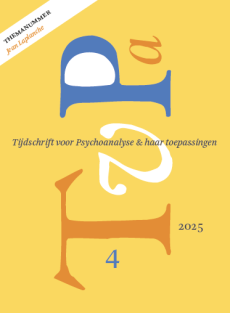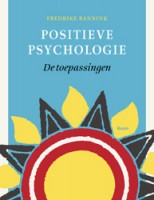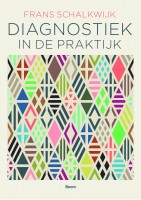Freuds ambivalentieconcept (1916-1940)
Summary
By his use of the concept of ambivalence, Freud mainly referred to ambivalence of feeling, prototypically the constellation of love and hate. Freud had a special interest in the neurotic forms of the conflicts of ambivalence, rooted in oedipal development. He gradually came to recognize that an understanding of the preoedipal development of ambivalence was of the utmost importance for the understanding of the interplay of love and hate in the narcissistic disorders, especially melancholia and paranoia. This led him to an appreciation of the specificity of the archaic fusion of life and death instincts. In normal early integration processes, aggression becomes a constructive element of libidinal feelings, while in pathology the aggressive component becomes more disruptive or even destructive and dominant.
Freud’s findings on preoedipal ambivalence of feeling are more fragmented than in the field of oedipal ambivalence. This seems to have stimulated post-Freudian psychoanalysis to investigate this field which Freud clearly demarcated but for the rest left untouched.
Literatuur
- Abraham, K. (1924). A short study of the development of the libido. In K. Abraham (1953) (red.), Selected papers on psychoanalysis (p. 418-501). New York: Basic Books.
- Brook, J.A. (1992). Freud and splitting. International Review of Psycho-analysis, 19, 335-351.
- Corveleyn, J. (1993). Onuitgegeven notities van het postgraduaat seminarie Dieptepsychologie over ‘splitsing’, Faculteit der psychologie en Pedagogische Wetenschappen; Katholieke Universiteit Leuven, de dato 22 februari 1993.
- Enriquez, E. (1984). De la horde à l’etat. Parijs: Presses Universitaires de France.
- Fairbairn, W.R. (1944). Endopsychic structure considered in terms of object relationships. In: W.R. Fairbairn (red.), An object-relations theory of the personality (p. 88-136). New York: Basic Books.
- Freud, A. (1965). Normality and pathology in childhood: Assessment of development. Hardmondsworth: Penguin Books. (Zie ook: The Writings of Anna Freud, 6.)
- Freud, A. (1974). A psychoanalytic view of developmental psychopathology. The Writings of Anna Freud, 8, 57-74. Harmondsworth: Penguin Books.
- Freud, S. (1895). Studien über Hysterie. Gesammelte Werke I (p. 75-312). (Frankfurt am Main: S. Fischer Verlag.
- Freud, S. (1905). Drei Abhandlungen zur Sexualtheorie. Gesammelte Werke V (p. 27-145). Frankfurt am Main: S. Fischer Verlag.
- Freud, S. (1909). Analyse der Phobie eines fünfjährigen Knaben. Gesammelte Werke VII (p. 241-377). Frankfurt am Main: S. Fischer Verlag.
- Freud, S. (1912-1913). Totem und Tabu. Gesammelte Werke IX. Frankfurt am Main: S. Fischer Verlag.
- Freud, S. (1915). Triebe und Triebschicksale. Gesammelte Werke X (p. 209-232). Frankfurt am Main: S. Fischer Verlag.
- Freud, S. (1916-1917). Vorlesungen zur Einführung in die Psychoanalyse. Gesammelte Werke XI. Frankfurt am Main: S. Fischer Verlag.
- Freud, S. (1917). Trauer und Melancholie. Gesammelte Werke X (p. 427-446). Frankfurt am Main: S. Fischer Verlag. Vertaling: Rouw en melancholie. Sigmund Freud: Nederlandse Editie: Psychoanalytische Theorie 1 (p. 65-86). Amsterdam: Boom.
- Freud, S. (1920a). Über die Psychogenese eines Falles von weiblicher Homoseksualität. Gesammelte Werke XII (p. 269-302). Frankfurt am Main: S. Fischer Verlag (1973). Vertaling: Over de psychogenese van een geval van homoseksualiteit bij een vrouw. Sigmund Freud, Nederlandse Editie: Ziektegeschiedenissen 2 (p. 175-209). Amsterdam: Boom.
- Freud, S. (1920b). Jenseits des Lustprinzips. Gesammelte Werke XIII (p. 1-69). Frankfurt am Main: S. Fischer Verlag. Vertaling: Aan gene zijde van het lustprincipe. Sigmund Freud, Nederlandse Editie: Psychoanalytische Theorie 1 (p. 93-165). Amsterdam: Boom.
- Freud, S. (1921). Massenpsychologie und Ich-Analyse. Gesammelte Werke XIII (p. 71-161). Frankfurt am Main: S. Fischer Verlag.
- Freud, S. (1922). Über einige neurotische Mechanismen bei Eifersucht, Paranoia und Homosexualität. Gesammelte Werke XIII (p. 193-207). Frankfurt am Main: S. Fischer Verlag.
- Freud, S. (1923). Das Ich und das Es. Gesammelte Werke XIII (p. 235-289). Frankfurt am Main: Fischer Verlag, 1973). Vertaling: Het Ik en het Es. Sigmund Freud, Nederlandse Editie: Psychoanalytische Theorie 3 (p. 9-82). Amsterdam: Boom.
- Freud, S. (1925). Einige psychische Folgen des anatomischen Geschlechtsunterschieds. Gesammelte Werke XIV (p. 17-30). Frankfurt am Main: S. Fischer Verlag.
- Freud, S. (1926). Hemmung, Symptom und Angst. Gesammelte Werke XIV (p. 111-205). Frankfurt am Main: S. Fischer Verlag.
- Freud, S. (1927). Zukunft einer Illusion. Gesammelte Werke XIV (p. 325-380). Frankfurt am Main: S. Fischer Verlag.
- Freud, S. (1930). Das Unbehagen in der Kultur. Gesammelte Werke XIV (p. 419-405) Frankfurt am Main: S. Fischer Verlag.
- Freud, S. (1931). Über die weibliche Sexualität. Gesammelte Werke XIV (p. 515-537). Frankfurt am Main: S. Fischer Verlag. Vertaling: Over de vrouwelijke seksualiteit. Sigmund Freud, Nederlandse Editie: Klinische Beschouwingen 3 (p. 121-145). Amsterdam: Boom.
- Freud, S. (1933). Neue Folge der Vorlesungen zur Einführung in die Psychoanalyse (w.o. ‘Die Weiblichkeit’ [p. 87-118] en ‘Angst und Triebleben’ [p. 119-145]) Gesammelte Werke XV. Frankfurt am Main: S. Fischer Verlag. Vertaling: Colleges inleiding tot de psychoanalyse – Nieuwe reeks. Sigmund Freud, Nederlandse Editie: Inleiding tot de Psychoanalyse 3. Amsterdam: Boom.
- Freud, S. (1939). Der Mann Moses und die monotheistische Religion. Gesammelte Werke XVI (p. 101-246). Frankfurt am Main: S. Fischer Verlag.
- Freud, S. (1940). Die Ichspaltung im Abwehrvorgang. Gesammelte Werke XVII (p. 57-62). Frankfurt am Main: S. Fischer Verlag.
- Groen, J. (1983). Geslachtsverschil. Een psychoanalytische verkenning. Meppel: Boom.
- Hartmann, H., Kris, E. & Löwenstein, R. (1949). Notes on the theory of aggression. Psychoanalytic Study of the Child, 3-4, 9-36.
- Heimann, P. (1949). Some notes on the psycho-analytic concept of introjected objects. International Journal of Psycho-Analysis, 22, 8-17.
- Jacobson, E. (1953). Affects and psychic discharge processes. In: R. Löwenstein (red.), Drives, affects, behaviour (p. 38-66). New York: International Universities Press.
- Kernberg, O. (1974). Severe personality disorders: Psychotherapeutic strategies. NewYork/Londen: Yale University Press.
- Klein, M. (1935). A contribution to the psychogenesis of manic-depressive states. In: M. Klein (red.) (1975), Love, guilt and reparation and other works 1921-1945 (p. 262-289). Londen: Hogarth Press.
- Klein, M. (1946). Notes on some schizoid mechanisms. In: M. Klein (1975) (red.), Envy and gratitude and other works 1946-1963 (p. 1-24). Londen: Hogarth Press.
- Kris, A. (1984). The conflicts of ambivalence. Psychoanalytic Study of the Child, 39, 213-234.
- Kris, A. (1988). Some clinical applications of the distinction between divergent and convergent conflicts. International Journal of Psychoanalysis, 69, 431-441.
- Lichtenberg, J.D. & Slap, J.W. (1973). Notes on the concept of splitting and the defence mechanism of splitting of representations. Journal of the American Psychoanalytic Association, 21, 772-787.
- Mahler, M., Pine, F. & Bergman, A. (1975). The psychological birth of the human infant. New York: Basic Books.
- Meurs, P. (1989). De vrouwelijkheid in de recente Franse psychoanalytische literatuur. Een controversieel thema. Onuitgegeven licentiaatverhandeling, Faculteit der Psychologie en Pedagogische Wetenschappen, Katholieke Universiteit Leuven (Promotor: Prof. dr. J. Corveleyn).
- Meurs, P. (2000). Gevoelsambivalentie in ontwikkelingsperspectief. Grondige literatuurstudie over een complex psychodynamisch basisconcept en empirisch onderzoek naar de structuur van positief en negatief affect. Onuitgegeven doctoraatsverhandeling, Faculteit der Psychologie en Pedagogische wetenschappen, Katholieke Universiteit Leuven (Promotor: Prof. Dr. G. Cluckers).
- Meurs, P. & Cluckers, G. (2002, in druk). Gevoelsambivalentie in ontwikkelingspsychopathologisch perspectief. Leuven/Apeldoorn: Garant.
- Meurs, P. & Corveleyn, J. (1990). Oude vragen, nieuwe antwoorden. Recente Franse literatuur omtrent vrouwelijkheid. Psychoanalyse, 6, 109-120.
- Szondi, L. (1968). Freiheit und Zwang im Schicksal des Einzelnen. Stuttgart/Bern: Hans Huber Verlag.
 © 2009-2025 Uitgeverij Boom Amsterdam
© 2009-2025 Uitgeverij Boom Amsterdam
ISSN 1382-516x
De artikelen uit de (online)tijdschriften van Uitgeverij Boom zijn auteursrechtelijk beschermd. U kunt er natuurlijk uit citeren (voorzien van een bronvermelding) maar voor reproductie in welke vorm dan ook moet toestemming aan de uitgever worden gevraagd:
Behoudens de in of krachtens de Auteurswet van 1912 gestelde uitzonderingen mag niets uit deze uitgave worden verveelvoudigd, opgeslagen in een geautomatiseerd gegevensbestand, of openbaar gemaakt, in enige vorm of op enige wijze, hetzij elektronisch, mechanisch door fotokopieën, opnamen of enig andere manier, zonder voorafgaande schriftelijke toestemming van de uitgever.
Voor zover het maken van kopieën uit deze uitgave is toegestaan op grond van artikelen 16h t/m 16m Auteurswet 1912 jo. Besluit van 27 november 2002, Stb 575, dient men de daarvoor wettelijk verschuldigde vergoeding te voldoen aan de Stichting Reprorecht te Hoofddorp (postbus 3060, 2130 KB, www.reprorecht.nl) of contact op te nemen met de uitgever voor het treffen van een rechtstreekse regeling in de zin van art. 16l, vijfde lid, Auteurswet 1912.
Voor het overnemen van gedeelte(n) uit deze uitgave in bloemlezingen, readers en andere compilatiewerken (artikel 16, Auteurswet 1912) kan men zich wenden tot de Stichting PRO (Stichting Publicatie- en Reproductierechten, postbus 3060, 2130 KB Hoofddorp, www.cedar.nl/pro).
No part of this book may be reproduced in any way whatsoever without the written permission of the publisher.
Nieuwsbrief Boom Psychologie
Meld u nu aan en ontvang maandelijks de Boom Psychologie nieuwsbrief met aantrekkelijke aanbiedingen en de nieuwe uitgaven.
Aanmelden


